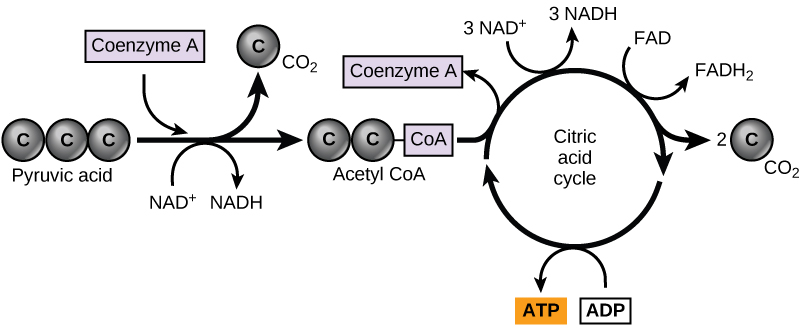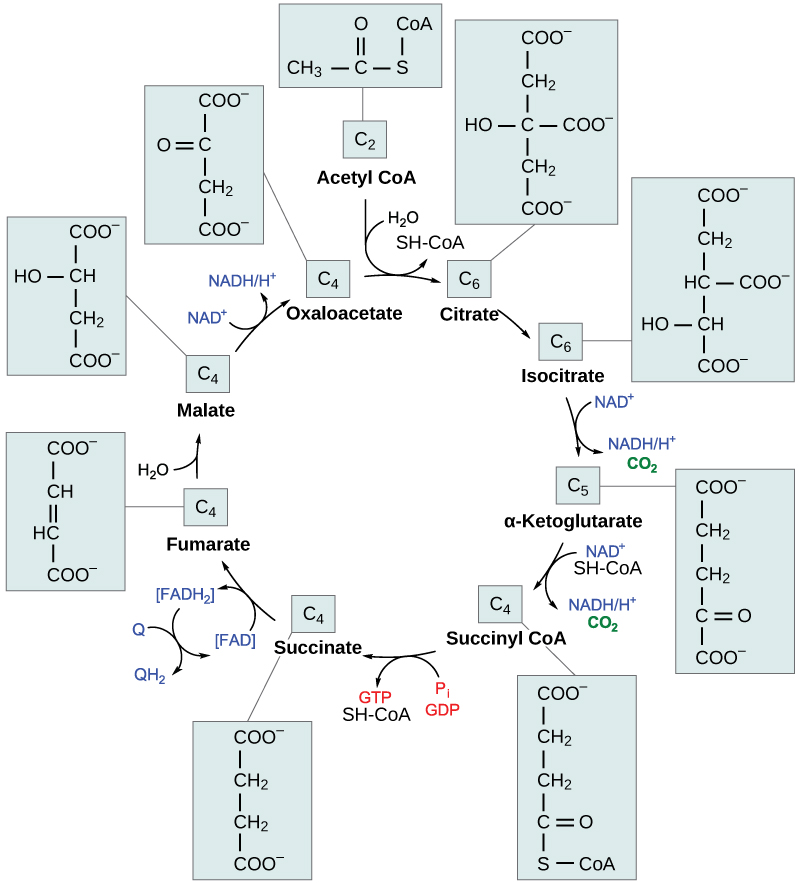23.3 Pyruvate Oxidation and the Citric Acid Cycle
By the end of the citric acid cycle, glucose is completely broken down. Each of its six carbons has been released as carbon dioxide, and all of the high energy electrons that can be harvested have been. They will be carried by NADH and FADH2 to the complexes of the electron transport chain.

Pyruvate Oxidation
In eukaryotic cells when oxygen gas is available, the pyruvate molecules produced at the end of glycolysis are transported into the matrix of a mitochondrion, where cellular respiration. If oxygen is available, aerobic respiration will go forward. In mitochondria, pyruvate will be transformed into a two-carbon acetyl group (by removing a molecule of carbon dioxide) that will be picked up by a carrier compound called coenzyme A (CoA), which is made from vitamin B5. The resulting compound is called acetyl CoA. Acetyl CoA can be used in a variety of ways by the cell, but its major function in respiration is to deliver the acetyl group derived from pyruvate to the citric acid cycle, the next step in glucose catabolism.
During pyruvate oxidation, the electrons released by pyruvate are transferred to NAD+, which is thus reduced to NADH. As pyruvate is oxidized, a carbon is removed. Note that during glucose metabolism, whenever a carbon atom is removed, it is released in a highly oxidized form bound to two oxygen atoms (CO2), one of the major end products of cellular respiration.
The Citric Acid Cycle
In the presence of oxygen, acetyl CoA delivers its acetyl (2C) group to a four-carbon molecule, oxaloacetate, to form citrate (citric acid), a six-carbon molecule with three carboxyl groups. This pathway will harvest the remainder of the extractable energy from what began as a glucose molecule and release an additional four CO2 molecules. This pathway is referred to by different names: the citric acid cycle (for the first intermediate formed—citric acid, or citrate—when acetate joins to the oxaloacetate), the TCA cycle (because citric acid or citrate and isocitrate are tricarboxylic acids), and the Krebs cycle, after Hans Krebs, who first identified the steps in the pathway in the 1930s in pigeon flight muscles.
Like the conversion of pyruvate to acetyl CoA, the citric acid cycle in eukaryotic cells takes place in the matrix of the mitochondria. Unlike glycolysis, the citric acid cycle is a closed loop: The last part of the pathway regenerates the compound used in the first step. The eight steps of the cycle are a series of chemical reactions that produces two carbon dioxide molecules, one ATP molecule (or an equivalent), and reduced forms (NADH and FADH2) of NAD+ and FAD+, important coenzymes in the cell.
This is considered an aerobic pathway because the NADH and FADH2 produced must transfer their electrons to the next pathway in the system, which will use oxygen. If this transfer does not occur, the oxidation steps of the citric acid cycle cannot occur. Note that the citric acid cycle produces very little ATP directly and does not directly consume oxygen.

Products of the Citric Acid Cycle
Two carbon atoms come into the citric acid cycle from each acetyl group, representing four out of the six carbons of one glucose molecule. Two carbon dioxide molecules are released on each turn of the cycle. Each turn of the cycle forms three NADH molecules and one FADH2 molecule. These carriers will connect with the last portion of aerobic respiration, the electron transport chain, to produce ATP molecules. One ATP (or GTP) is also made in each cycle.
(also Krebs cycle) series of enzyme-catalyzed chemical reactions that completes glucose catabolism during cellular respiration
three-carbon sugar that can be decarboxylated and oxidized to make acetyl CoA, which enters the citric acid cycle under aerobic conditions; the end product of glycolysis
combination of an acetyl group (two carbons) derived from pyruvate and coenzyme A
the conversion of pyruvate into an acetyl group, which takes place when electrons from pyruvate are transferred to NAD+

